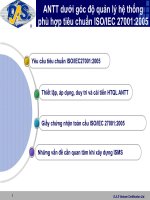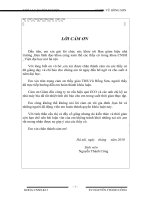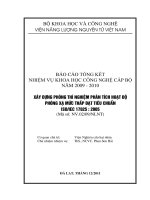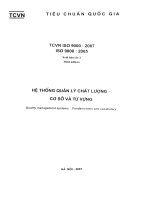Tiêu chuẩn tiêu chuẩn iso 05495 2005 amd1 2016
Bạn đang xem bản rút gọn của tài liệu. Xem và tải ngay bản đầy đủ của tài liệu tại đây (241.21 KB, 8 trang )
INTERNATIONAL
STANDARD
ISO
5495
Third edition
2005-11-15
AMENDMENT 1
2016-02-15
Sensory analysis — Methodology —
Paired comparison test
AMENDMENT 1
Analyse sensorielle — Méthodologie — Essai de comparaison par
paires
AMENDEMENT 1
Reference number
ISO 5495:2005/Amd.1:2016(E)
© ISO 2016
ISO 5495:2005/Amd.1:2016(E)
COPYRIGHT PROTECTED DOCUMENT
© ISO 2016, Published in Switzerland
All rights reserved. Unless otherwise specified, no part o f this publication may be reproduced or utilized otherwise in any form
or by any means, electronic or mechanical, including photocopying, or posting on the internet or an intranet, without prior
written permission. Permission can be requested from either ISO at the address below or ISO’s member body in the country o f
the requester.
ISO copyright o ffice
Ch. de Blandonnet 8 • CP 401
CH-1214 Vernier, Geneva, Switzerland
Tel. +41 22 749 01 11
Fax +41 22 749 09 47
www.iso.org
ii
© ISO 2016 – All rights reserved
ISO 5495:2005/Amd.1:2016(E)
Foreword
ISO (the International Organization for Standardization) is a worldwide federation of national standards
bodies (ISO member bodies). The work o f preparing International Standards is normally carried out
through ISO technical committees. Each member body interested in a subject for which a technical
committee has been established has the right to be represented on that committee. International
organizations, governmental and non-governmental, in liaison with ISO, also take part in the work.
ISO collaborates closely with the International Electrotechnical Commission (IEC) on all matters o f
electrotechnical standardization.
The procedures used to develop this document and those intended for its further maintenance are
described in the ISO/IEC Directives, Part 1. In particular the different approval criteria needed for the
di fferent types o f ISO documents should be noted. This document was dra fted in accordance with the
editorial rules of the ISO/IEC Directives, Part 2 (see www.iso.org/directives).
Attention is drawn to the possibility that some o f the elements o f this document may be the subject o f
patent rights. ISO shall not be held responsible for identi fying any or all such patent rights. Details o f
any patent rights identified during the development o f the document will be in the Introduction and/or
on the ISO list of patent declarations received (see www.iso.org/patents).
Any trade name used in this document is in formation given for the convenience o f users and does not
constitute an endorsement.
For an explanation on the meaning o f ISO specific terms and expressions related to con formity
assessment, as well as information about ISO’s adherence to the WTO principles in the Technical
Barriers to Trade (TBT) see the following URL: Foreword - Supplementary in formation .
The committee responsible for this document is ISO/TC 34, Food products, Subcommittee SC 12,
Sensory analysis.
© ISO 2016 – All rights reserved
iii
ISO 5495:2005/Amd.1:2016(E)
Sensory analysis — Methodology — Paired comparison test
AMENDMENT 1
Page 15, Annex B, B.5.2
Replace B.5.2 with the following:
B.5.2
Analysis and interpretation of results
In Example 1 (one-sided paired test), the data were as follows: n = 30, x = 21, α = 0,05. From these data,
the analyst calculates
—
—
p c = x/n = 21/30 = 0,7,
—
sd (standard error of p d )
pˆ d
(proportion of distinguishers) = 2 p c − 1 = 2 × 0, 7 − 1 = 0, 4 ,
(×
)
(
)
= 0, 167 , and
— 95 % one-sided lower confidence limit = pˆ d − zα s d = 0, 4 − 1, 64 × 0, 167 = 0, 125 .
=2
n
x − x2 / n3
=2
30 × 21 − 21 2 / 30 3
The sensory analyst can there fore be 95 % certain that the proportion o f consumers who perceive the
prototype to be crispier than the control is larger than the proportion o f consumers who perceive the
control to be crispier than the prototype by at least 12 %. This result agrees with the conclusion given
in Example 1, since it shows that the one-sided confidence interval does not contain the null value.
In Example 3 (two-sided paired difference test), the data were as follows: n = 44, x = 32, α = 0,05. It
follows that
— pc = x/n = 32/44 = 0,73,
— pˆ d (proportion of distinguishers) = 2 p c − 1 = 2 × 0, 73 − 1 = 0, 45 ,
—
sd (standard error of p d )
=2
(n
× x − x2) / n3 = 2
( 44
× 32 − 32 2 ) / 44 3 = 0, 134 ,
— 95 % upper confidence limit = pˆ d + zα/2 sd = 0,45 + 1,96 × 0,134 = 0,71, and
— 95 % lower confidence limit =
pˆ d
− zα 2 s d = 0, 45 − 1, 96 × 0, 134 = 0, 19 .
The sensory analyst can there fore be 95 % certain that at least 19 % and at most 71 % o f the
population is capable of distinguishing the samples. This result concords with the conclusion given in
Example 3, indicating sample A as being saltier, since it shows that the confidence interval does not
contain the null value.
In Example 4 (two-sided paired similarity test), the data were as follows: n = 120, x = 67, β = 0,05 and
the critical pd = 30 %. In the two-sided case, the value of x is chosen to be the maximum of the two
choice counts, regardless of which sample was chosen most often. The calculation therefore gives
— pc = x/n = 67/120 = 0,56,
— pˆ d (proportion of distinguishers) = 2 p c − 1 = 2 × 0, 56 − 1 = 0, 12 ,
—
sd (standard error of p d )
© ISO 2016 – All rights reserved
=2
(×
n
)
x − x2 / n3
=2
(
)
120 × 67 − 67 2 / 120 3
= 0, 09 , and
1
ISO 5495:2005/Amd.1:2016(E)
—
9 5 % upp er con fidence l i m it =
ˆ
p
d + zβ/2 sd = 0,12 + 1,96 × 0,09 = 0,29.
T he s en s or y ana lys t c a n there fore b e 9 5 % cer tai n that the ac tua l prop or tion o f the p opu lation c ap able
o f d i s ti ngui s h i ng the s a mple s i s no gre ater th an 2 9 % . For the s i m i la rity te s t, the ana lys t cho s e the
con fidence level to b e 10 0 (1 –
p
d
β)
= 95 %. Since 29 % is less than the pre-established limit (i.e. critical
= 3 0 %) , the ana lys t c an conclude with 9 5 % con fidence that the s a mp le s a re s u fficiently s i m i la r i n
s ur face sl ip to b e u s e d i nterch ange ably.
Since x
wa s defi ne d as the ma xi mu m choice cou nt rega rd le s s o f wh ich s ample re ceive d the h igher cou nt,
on ly the upp er-l i m it o f the two - s ide d con fidence i nter va l ne e d s to b e c a lc u l ate d .
2
© ISO 2016 – All rights reserved
ISO 5495:2005/Amd.1:2016(E)
ICS 67.2 40
Price based on 2 pages
© ISO 2016 – All rights reserved









